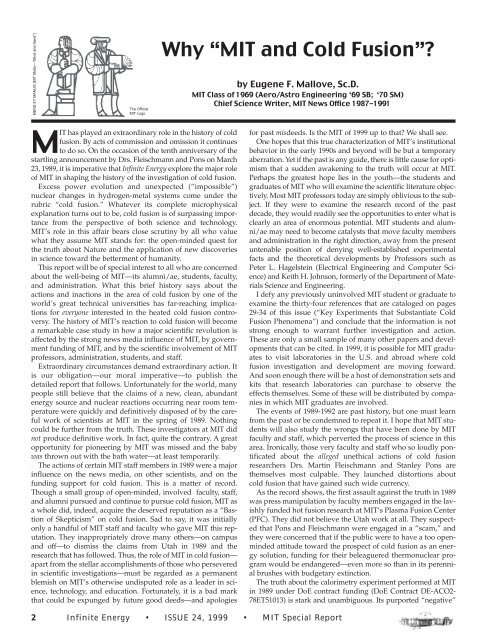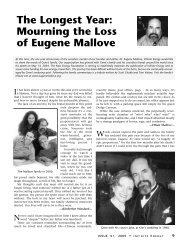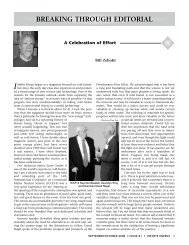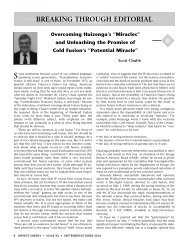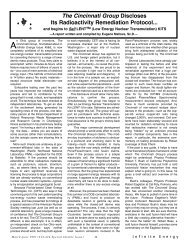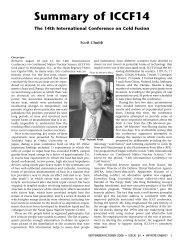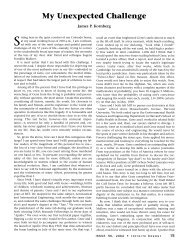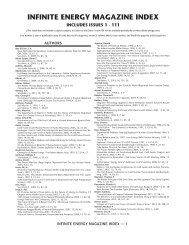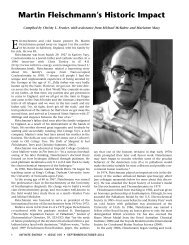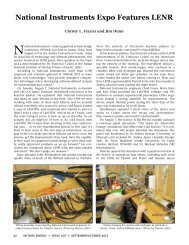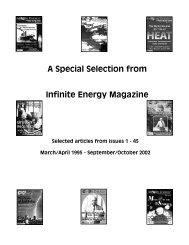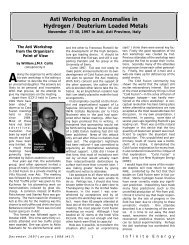MIT and Cold Fusion: A Special Report - Infinite Energy Magazine
MIT and Cold Fusion: A Special Report - Infinite Energy Magazine
MIT and Cold Fusion: A Special Report - Infinite Energy Magazine
You also want an ePaper? Increase the reach of your titles
YUMPU automatically turns print PDFs into web optimized ePapers that Google loves.
MENS ET MANUS [<strong>MIT</strong> Motto—”Mind <strong>and</strong> H<strong>and</strong>”]<br />
The Official<br />
<strong>MIT</strong> Logo<br />
Why “<strong>MIT</strong> <strong>and</strong> <strong>Cold</strong> <strong>Fusion</strong>”?<br />
by Eugene F. Mallove, Sc.D.<br />
<strong>MIT</strong> Class of 1969 (Aero/Astro Engineering ‘69 SB; ‘70 SM)<br />
Chief Science Writer, <strong>MIT</strong> News Office 1987-1991<br />
<strong>MIT</strong> has played an extraordinary role in the history of cold<br />
fusion. By acts of commission <strong>and</strong> omission it continues<br />
to do so. On the occasion of the tenth anniversary of the<br />
startling announcement by Drs. Fleischmann <strong>and</strong> Pons on March<br />
23, 1989, it is imperative that <strong>Infinite</strong> <strong>Energy</strong> explore the major role<br />
of <strong>MIT</strong> in shaping the history of the investigation of cold fusion.<br />
Excess power evolution <strong>and</strong> unexpected (“impossible”)<br />
nuclear changes in hydrogen-metal systems come under the<br />
rubric “cold fusion.” Whatever its complete microphysical<br />
explanation turns out to be, cold fusion is of surpassing importance<br />
from the perspective of both science <strong>and</strong> technology.<br />
<strong>MIT</strong>’s role in this affair bears close scrutiny by all who value<br />
what they assume <strong>MIT</strong> st<strong>and</strong>s for: the open-minded quest for<br />
the truth about Nature <strong>and</strong> the application of new discoveries<br />
in science toward the betterment of humanity.<br />
This report will be of special interest to all who are concerned<br />
about the well-being of <strong>MIT</strong>—its alumni/ae, students, faculty,<br />
<strong>and</strong> administration. What this brief history says about the<br />
actions <strong>and</strong> inactions in the area of cold fusion by one of the<br />
world’s great technical universities has far-reaching implications<br />
for everyone interested in the heated cold fusion controversy.<br />
The history of <strong>MIT</strong>’s reaction to cold fusion will become<br />
a remarkable case study in how a major scientific revolution is<br />
affected by the strong news media influence of <strong>MIT</strong>, by government<br />
funding of <strong>MIT</strong>, <strong>and</strong> by the scientific involvement of <strong>MIT</strong><br />
professors, administration, students, <strong>and</strong> staff.<br />
Extraordinary circumstances dem<strong>and</strong> extraordinary action. It<br />
is our obligation—our moral imperative—to publish the<br />
detailed report that follows. Unfortunately for the world, many<br />
people still believe that the claims of a new, clean, abundant<br />
energy source <strong>and</strong> nuclear reactions occurring near room temperature<br />
were quickly <strong>and</strong> definitively disposed of by the careful<br />
work of scientists at <strong>MIT</strong> in the spring of 1989. Nothing<br />
could be further from the truth. These investigators at <strong>MIT</strong> did<br />
not produce definitive work. In fact, quite the contrary. A great<br />
opportunity for pioneering by <strong>MIT</strong> was missed <strong>and</strong> the baby<br />
was thrown out with the bath water—at least temporarily.<br />
The actions of certain <strong>MIT</strong> staff members in 1989 were a major<br />
influence on the news media, on other scientists, <strong>and</strong> on the<br />
funding support for cold fusion. This is a matter of record.<br />
Though a small group of open-minded, involved faculty, staff,<br />
<strong>and</strong> alumni pursued <strong>and</strong> continue to pursue cold fusion, <strong>MIT</strong> as<br />
a whole did, indeed, acquire the deserved reputation as a “Bastion<br />
of Skepticism” on cold fusion. Sad to say, it was initially<br />
only a h<strong>and</strong>ful of <strong>MIT</strong> staff <strong>and</strong> faculty who gave <strong>MIT</strong> this reputation.<br />
They inappropriately drove many others—on campus<br />
<strong>and</strong> off—to dismiss the claims from Utah in 1989 <strong>and</strong> the<br />
research that has followed. Thus, the role of <strong>MIT</strong> in cold fusion—<br />
apart from the stellar accomplishments of those who persevered<br />
in scientific investigations—must be regarded as a permanent<br />
blemish on <strong>MIT</strong>’s otherwise undisputed role as a leader in science,<br />
technology, <strong>and</strong> education. Fortunately, it is a bad mark<br />
that could be expunged by future good deeds—<strong>and</strong> apologies<br />
for past misdeeds. Is the <strong>MIT</strong> of 1999 up to that? We shall see.<br />
One hopes that this true characterization of <strong>MIT</strong>’s institutional<br />
behavior in the early 1990s <strong>and</strong> beyond will be but a temporary<br />
aberration. Yet if the past is any guide, there is little cause for optimism<br />
that a sudden awakening to the truth will occur at <strong>MIT</strong>.<br />
Perhaps the greatest hope lies in the youth—the students <strong>and</strong><br />
graduates of <strong>MIT</strong> who will examine the scientific literature objectively.<br />
Most <strong>MIT</strong> professors today are simply oblivious to the subject.<br />
If they were to examine the research record of the past<br />
decade, they would readily see the opportunities to enter what is<br />
clearly an area of enormous potential. <strong>MIT</strong> students <strong>and</strong> alumni/ae<br />
may need to become catalysts that move faculty members<br />
<strong>and</strong> administration in the right direction, away from the present<br />
untenable position of denying well-established experimental<br />
facts <strong>and</strong> the theoretical developments by Professors such as<br />
Peter L. Hagelstein (Electrical Engineering <strong>and</strong> Computer Science)<br />
<strong>and</strong> Keith H. Johnson, formerly of the Department of Materials<br />
Science <strong>and</strong> Engineering.<br />
I defy any previously uninvolved <strong>MIT</strong> student or graduate to<br />
examine the thirty-four references that are cataloged on pages<br />
29-34 of this issue (“Key Experiments that Substantiate <strong>Cold</strong><br />
<strong>Fusion</strong> Phenomena”) <strong>and</strong> conclude that the information is not<br />
strong enough to warrant further investigation <strong>and</strong> action.<br />
These are only a small sample of many other papers <strong>and</strong> developments<br />
that can be cited. In 1999, it is possible for <strong>MIT</strong> graduates<br />
to visit laboratories in the U.S. <strong>and</strong> abroad where cold<br />
fusion investigation <strong>and</strong> development are moving forward.<br />
And soon enough there will be a host of demonstration sets <strong>and</strong><br />
kits that research laboratories can purchase to observe the<br />
effects themselves. Some of these will be distributed by companies<br />
in which <strong>MIT</strong> graduates are involved.<br />
The events of 1989-1992 are past history, but one must learn<br />
from the past or be condemned to repeat it. I hope that <strong>MIT</strong> students<br />
will also study the wrongs that have been done by <strong>MIT</strong><br />
faculty <strong>and</strong> staff, which perverted the process of science in this<br />
area. Ironically, those very faculty <strong>and</strong> staff who so loudly pontificated<br />
about the alleged unethical actions of cold fusion<br />
researchers Drs. Martin Fleischmann <strong>and</strong> Stanley Pons are<br />
themselves most culpable. They launched distortions about<br />
cold fusion that have gained such wide currency.<br />
As the record shows, the first assault against the truth in 1989<br />
was press manipulation by faculty members engaged in the lavishly<br />
funded hot fusion research at <strong>MIT</strong>’s Plasma <strong>Fusion</strong> Center<br />
(PFC). They did not believe the Utah work at all. They suspected<br />
that Pons <strong>and</strong> Fleischmann were engaged in a “scam,” <strong>and</strong><br />
they were concerned that if the public were to have a too openminded<br />
attitude toward the prospect of cold fusion as an energy<br />
solution, funding for their beleaguered thermonuclear program<br />
would be endangered—even more so than in its perennial<br />
brushes with budgetary extinction.<br />
The truth about the calorimetry experiment performed at <strong>MIT</strong><br />
in 1989 under DoE contract funding (DoE Contract DE-ACO2-<br />
78ET51013) is stark <strong>and</strong> unambiguous. Its purported “negative”<br />
2 <strong>Infinite</strong> <strong>Energy</strong> • ISSUE 24, 1999 • <strong>MIT</strong> <strong>Special</strong> <strong>Report</strong>


